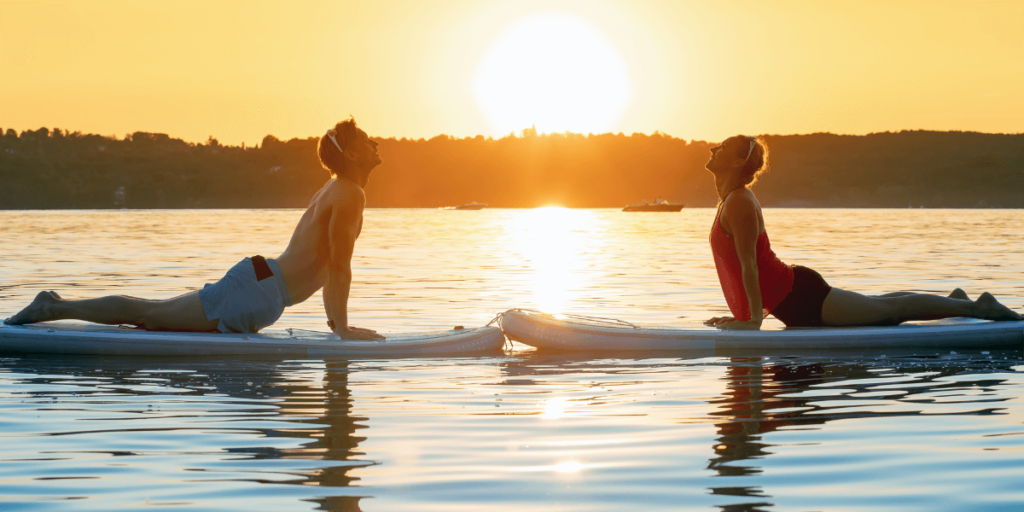Standup paddle board (SUP) yoga is a form of yoga that offers a wide range of health benefits, such as improved fitness, decreased risk of injuries, increased strength, balance, stability, and more — not to mention quality time on the water. Not just a gimmick, one 2016 research study found that SUP yoga can help improve psychological, cardiovascular, and musculoskeletal health.
SUP yoga combines paddle boarding with yoga to increase mobility, improve flexibility, increase range of motion, and strengthen muscles. Focused breathing is a vital part of SUP yoga, which increases blood circulation to all parts of the body, including the brain, reducing stress and promoting relaxation.
What is SUP Yoga?
SUP is a recreational water sport that originated in Hawaii and has become popular worldwide. It is similar to surfing and requires balance. In most instances, practice begins with a short warm-up paddle, allowing you to use the equipment before moving forward with your yoga flow and breathing exercises.
Unlike practicing yoga on land, SUP yoga focuses on combining Vinyasa and Hatha flows, requiring you to adjust your body differently to achieve balance and stability, especially on unstable water. For this reason, SUP yoga requires more focus and balance to perform poses while staying steady on the paddleboard.

How to Practice SUP Yoga
SUP yogis recommend taking lessons before including this type of yoga in your exercise regime. If you have not used a paddleboard before, you should test your skills before attempting your first class on the water.
Once you have a basic understanding of standup paddleboarding, it’s time to take your yoga practice to the board. Many on-the-water lessons provide you with equipment rentals, however, if you’d like to purchase your own paddleboard specifically for yoga, we recommend the Venice Board by Nixy Sports. This board is inflatable so you can take it anywhere, better yet, it’s extra stable and perfect for balancing during practice.“The Venice provides extreme stability when it comes to SUP Yoga. It’s smooth and comfortable traction pad will feel like a yoga mat floating on water as you flow through each pose,” recommends Alexandra Artigas, founder of Nixy Sports.
Other essential gear or accessories you may need are anchors, water-resistant clothing, a safety whistle, sunscreen, water bottle, board leashes, and shoulder straps. Invest in a comfortable yoga mat to avoid bruising and injuring your ankles and knees.
Once you are on the water, it’s imperative that you remain calm and focus on balance and breathing. Instead of rushing through your practice, take time in each pose and find stability.
SUP Yoga Poses for Beginners
Unlike regular yoga practice, SUP yoga develops more focus, balance, mindfulness, and breathing skills. The only downside of SUP yoga is that it can be difficult to hold your balance. Here are a few yoga poses to get you started and to build balance.

Plank Pose
Plank pose is a foundational yoga pose that strengthens your core, back, shoulder, arms, and neck muscles. Additionally, because it is lower to the board, it may be easier to balance for beginners. See a full tutorial on Plank Pose here.

Mountain Pose
Mountain pose improves your body awareness, alignment, stability, posture and strengthens your legs. On a board, this pose requires extra balance and stillness. See a full tutorial on Mountain Pose here.

Cobra Pose
Cobra Pose is an effective yoga pose that strengthens your spine, stretches your abdomen, shoulders, and torso, stimulates core muscles, relieves spinal and sciatic pain, and improves stress symptoms. On a board, this pose requires balance, focus, and time. Because this pose is very close to the board, it may be easier to maintain your positioning and stability. Learn Cobra Pose here.



